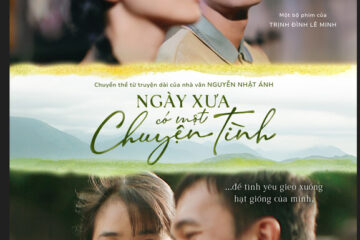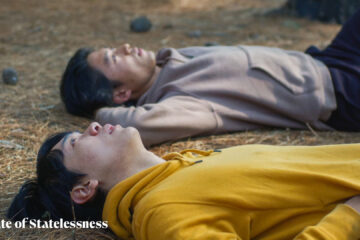In this interview, director Bảo Nguyễn discusses his creative approach to crafting The Stringer, a gripping documentary that balances emotional honesty with fact-seeking rigor. Inspired by journalism films and guided by the idea that cinema is memory, the film explores themes of authorship and accountability. Learn how collaboration with participants and innovative use of archival materials brought overlooked voices and complex truths to life – sparking a long-overdue conversation about the perspective behind the iconic “Napalm Girl” photograph.
Interviewee: Bảo Nguyễn, director of The Stringer
Interviewer: Jenn Thảo Nguyễn
You have previously mentioned that your work aims to make the epic intimate, and the intimate epic. Was there a particular film or piece of art that first inspired this pursuit for you?
The film Hoop Dreams (1994) by Steve James was deeply formative for me. It showed how a seemingly simple story about two kids chasing a dream could carry operatic weight when told with emotional intimacy and temporal scale. It taught me that cinema has the ability to compress time and space while expanding emotion and meaning. That idea – that everyday lives can reflect epic truths – has always stayed with me.
Unpacking mythology is a core value in your craft. How do you navigate the balance between connecting with the emotional core of your subject and ensuring factual clarity for your audience?
Speaking to film’s power, Guillermo del Toro once said, “At its highest function, cinema is memory. It tells us things that we remember, but never happened to us”. I try to guide my work by that principle. Emotional honesty is essential, but it’s never an excuse to blur facts. The tension between emotional resonance and factual precision is where I believe the most meaningful documentary work lives. I aim to create something that feels lived-in and human, while never losing sight of the complexity and nuance of the truth.
How did you decide on Gary Knight (VII Photo Agency co-founder) as the audience’s surrogate in The Stringer? Were there other narrative structures you considered for the film?
It was Gary’s own pursuit of the truth that catalyzed the story, so not including his journey as part of the narrative felt disingenuous. He’s not a narrator in the omniscient sense – he’s a conduit, experiencing revelations alongside the audience. At the same time, I’m very aware of the optics and dynamics of centering a white, Western journalist in a story about overlooked Vietnamese voices. But Gary’s willingness to interrogate the institutions he’s part of – and to acknowledge his own privilege – made that tension something we could wrestle with directly in the film. That tension became part of the story itself, and my hope is that it opens the door for a deeper reckoning around authorship, representation, and accountability.
Access is an incredibly pertinent aspect of documentary filmmaking. How has your approach to subject access evolved over the course of your film/filmography?
I used to think I was making films about people. Now, I try to make films with people. That shift – from subject to collaborator – has been foundational. Even the term “subject” can feel objectifying; it implies distance, a gaze imposed. I prefer “participant” because it better reflects the reciprocity and shared authorship that documentary filmmaking demands. Participants aren’t just offering time and testimony – they’re offering memory, identity, and legacy. The responsibility to honor that is immense.
The reenactment sequences in The Stringer pay close attention to the materiality of the medium. What guides your decision-making when choosing between archival footage and reenactments?
Archival footage should never be treated as wallpaper. It needs to have life, story, and texture – it has to breathe. When we use archival footage, we treat it like a scene, not filler. So when we decide to stage a reenactment, it must meet that same bar. It has to feel tactile and immersive, not like a dramatization, but like a recovered memory. The aim is always to preserve the emotional truth of a moment – even if we have to reimagine its visual form – without disrupting the viewer’s belief in the experience.
In an interview about The Greatest Night in Pop (2024), your documentary on the creation of the song “We Are the World”, you mentioned drawing storytelling inspiration from heist films. Were there any narrative or genre films that similarly influenced the visual language of The Stringer?
I’ve always been drawn to journalism films like All the President’s Men (1976), The Insider (1999), Spotlight (2015), and She Said (2022). They manage to make the act of chasing information feel as suspenseful and emotionally charged as any thriller. That sense of revelation and stakes – quiet, but seismic – definitely influenced The Stringer. It’s less about style and more about tone – the steady accumulation of facts leading to moral and emotional weight.
The culminating sequence in your documentary’s storytelling was the investigative animation. Could you walk us through the process of how that sequence was developed and constructed?
That sequence was born out of our collaboration with INDEX, a forensic imaging company that brought a whole new layer of rigor and clarity to the investigation. They combed through archival photos and videos, conducted frame-by-frame comparisons, and used modern forensic tools to evaluate what happened over 50 years ago. Their work wasn’t just technical – it was revelatory. It gave us a structured visual language to convey findings that were otherwise invisible to the eye.
What would you say was your greatest challenge – and your greatest triumph – while shaping a documentary of such discursive nature?
The greatest challenge was resisting the urge to land on a clean, singular truth in a story that is anything but. The Stringer asks uncomfortable questions and leaves room for ambiguity – because that’s the space where real conversations happen. The triumph, for me, was watching our participants – especially Vietnamese journalists who have long been overlooked – step into their power and tell their stories on their terms. We often hear that history belongs to everyone. But in reality, it belongs to those we choose to listen to. I hope this film broadens the circle of who gets heard.
The Stringer will be shown in-person at 7:00 PM on Saturday, October 11 at the Frida Cinema in Santa Ana. It will be followed by a discussion with Bảo Nguyễn.


